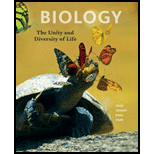
Concept explainers
Introduction: Most animals have excretory organs with a tubular structure. Body fluids enter into the one end of the tube. As these fluids enter through the tube, water and essential solutes leave the tube and return to the body fluid. Waste continues to the end of the tube and is eliminated from the body.
Answer to Problem 1SQ
Correct answer:
Option c. is given as “Malpighian tubules”. It removes the nitrogenous waste.
Therefore, optionc. is correct.
Explanation of Solution
Reasons for the correct statement:
Malpighian tubules are tubular excretory organs that deliver nitrogenous waste and other substances to the waste-processing portion of the digestive tract.
Hence, optionc. is correct.
Reasons for the incorrect statements:
Option a. is given as “nephridia”. A nephridium takes up coelomic fluid, adjusts its content, and releases waste through a pore in the body wall.
Therefore, option a. is an incorrect answer.
Option b. is given as “nephrons”. Nephrons are tiny tubules present in the kidney that produce urine.
Therefore, option b. is an incorrect answer.
Option d. is given as “contractile vacuoles”. The contractile vacuole that is present in the cell involves in osmoregulation.
Therefore, option d. is an incorrect answer.
Hence, options a, b., and d. are incorrect answers.
An insect’s malpighian tubules deliver nitrogen-rich waste to its gut.
Want to see more full solutions like this?
Chapter 40 Solutions
Biology: The Unity and Diversity of Life (MindTap Course List)
- Long nephron loopsa. are common in animals with access to abundant freshwater.b. allow urine to become concentrated within thecollecting duct.c. are the most common type of nephron loop in humans.d. extend deep into the renal cortex.arrow_forwardWhich nephron structure is often longer in animals adapted to desert environments? a. Glomerulus b. Bowman's capsule c. Distal and Proximal tubules d. Loop of Henlearrow_forwardMarine reptiles eliminate excess salt bya. transport across their gills.b. excretion through salt glands.c. reabsorption in the nephron tubules.d. excretion through the cloaca.arrow_forward
- A viral infection that specifically interferes with the reabsorption of ions from the glomerular filtrate would attack cells located in thea. Bowman’s capsule.b. glomerulus.c. renal tubules.d. collecting duct.arrow_forwardIn flatworms, flame cells are involved in what metabolic process?a. reproduction c. locomotionb. digestion d. osmoregulationarrow_forwardWhich of the following is not a correct pair? (a) protonephridia; flatworm (b) metanephridia; annelid (c) flame cell; flatworm (d) Malpighian tubule; mollusk (e) kidney; vertebratearrow_forward
- Why don’t birds have a bladder?arrow_forwardWhich of these is not a function of the kidneys? A) The kidneys regulate the plasma volume B) The kidneys help to regulate blood pressure C) The kidneys help control the rate of red blood cell production D) The kidneys deactivate vitamin D and stimulate the activity of osteoclastsarrow_forwardCompare the excretory systems of a flatworm and an annelid worm. How are they similar? How are they different?arrow_forward
- Name the following:(a) A chordate animal having flame cells as excretory structures.(b) Cortical portions projecting between the medullary pyramids in the human kidney.arrow_forwardThe highest incidence of bladder infection would be expected in? A) females, because of short urethra B) females, because of long urethra C) males, because of long urethra D) males, because of short urethraarrow_forwardIn the flatworm, flame cells are involved in what metabolic process? a. Reproduction b. Digestion c. Locomotion d. Osmoregulationarrow_forward
 Biology: The Unity and Diversity of Life (MindTap...BiologyISBN:9781305073951Author:Cecie Starr, Ralph Taggart, Christine Evers, Lisa StarrPublisher:Cengage Learning
Biology: The Unity and Diversity of Life (MindTap...BiologyISBN:9781305073951Author:Cecie Starr, Ralph Taggart, Christine Evers, Lisa StarrPublisher:Cengage Learning


